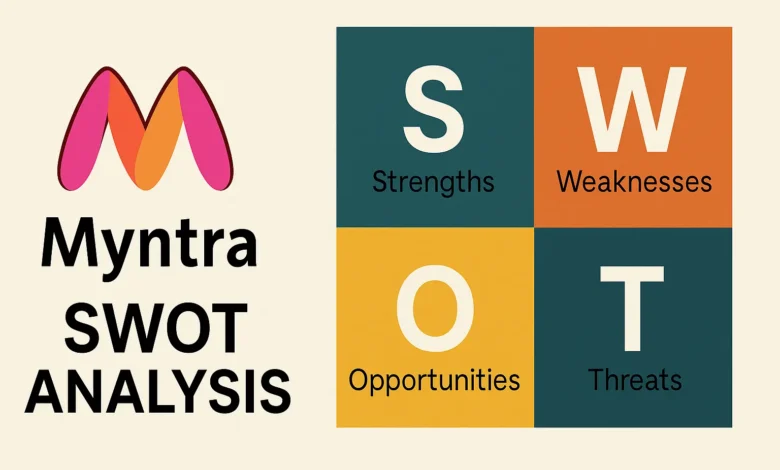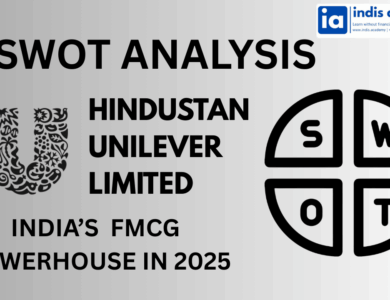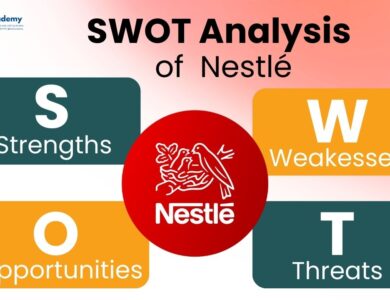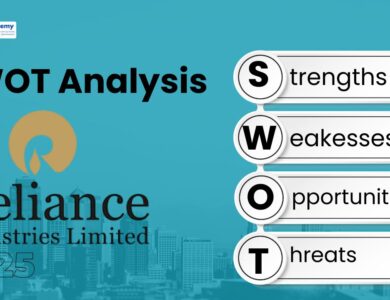Myntra SWOT Analysis: Key Insights into the Online Fashion Leader
"Explore Myntra's SWOT analysis—uncover strengths, challenges, and future opportunities shaping India's leading online fashion platform in a fast-evolving e-commerce landscape."

When it comes to online fashion shopping in India, Myntra is often the first name that pops into people’s minds. From stylish apparel and footwear to exclusive brand collaborations, Myntra has carved a unique identity that blends fashion with tech-savvy convenience.
But what exactly makes this brand stand tall in a fiercely competitive e-commerce market? And more importantly—what challenges does it face beneath the surface?
In this article, we’ll take a closer look at Myntra through a detailed SWOT analysis—breaking down its Strengths, Weaknesses, Opportunities, and Threats.
Whether you’re a business student, a startup founder looking to decode big-brand strategies, or simply a curious reader, this deep dive will offer you key insights into how Myntra operates, innovates, and adapts in a fast-changing industry.
Get ready to discover what truly drives Myntra’s success—and where it needs to tread carefully to stay ahead in India’s billion-dollar fashion race.
Also Read: Complete SWOT Analysis of Zomato – How It Dominates the Food Delivery Market
Company Overview of Myntra
Launched in 2007, Myntra started out as a platform for personalized gift items before pivoting into the fashion e-commerce space—a move that would redefine its future.
Today, Myntra stands as one of India’s most prominent online fashion and lifestyle retailers, known for offering a vast catalog of clothing, footwear, accessories, beauty products, and home essentials from over 5,000 national and international brands.
In 2014, Myntra was acquired by Flipkart, and together, the duo created a stronghold in India’s e-commerce ecosystem. With the added backing of Walmart (which owns a majority stake in Flipkart), Myntra gained access to global expertise, cutting-edge logistics, and aggressive growth strategies.
Myntra’s customer base spans across metros and emerging Tier 2 and Tier 3 cities, making it a truly pan-India platform. With innovations like Myntra Studio, Myntra Insider loyalty program, and AI-powered recommendations, the brand has consistently blurred the line between shopping and entertainment, especially for the fashion-forward Gen Z and millennial crowd.
In short, Myntra is not just selling clothes—it’s selling a lifestyle.
Strengths of Myntra
Every successful brand has a few aces up its sleeve—and for Myntra, these strengths have helped it lead the fashion e-commerce game in India. Let’s explore what makes this brand such a dominant force:
1. Strong Brand Recall in Fashion Retail
Myntra has positioned itself as India’s go-to online fashion destination. Over the years, its consistent messaging around style, quality, and convenience has built immense trust among urban and semi-urban shoppers. The brand isn’t just known—it’s remembered, and that’s powerful.
2. Exclusive Brand Partnerships
Myntra holds exclusive rights to host global and domestic fashion labels like HRX by Hrithik Roshan, Mango, H&M (select campaigns), and Roadster—its own private label that has become a brand in itself. These partnerships offer limited availability, giving Myntra an edge over generic e-commerce platforms.
3. Superior App Experience and Personalization
With a mobile-first strategy, Myntra’s app is intuitive, fast, and packed with smart features. From AI-based style suggestions to real-time outfit recommendations, users enjoy a tailor-made shopping journey. The platform also learns individual preferences over time, increasing engagement and repeat purchases.
Also Read: Complete SWOT Analysis of Mahindra – How the Brand Continues to Lead the Indian Market
4. Strong Logistics and Delivery Network
Myntra’s backbone is its robust logistics infrastructure that ensures timely deliveries and efficient return pickups—even in remote regions. Leveraging Flipkart’s supply chain, Myntra offers quick turnaround times, which is critical in a time-sensitive fashion industry.
5. Influencer-Driven Content and Myntra Studio
Myntra is not just selling products—it’s building a community. With Myntra Studio, the brand showcases influencer looks, trend stories, and shoppable content that bridges entertainment and commerce. This content-driven commerce approach has helped it engage users beyond just browsing.
6. Backing from Flipkart & Walmart
Being part of the Flipkart-Walmart ecosystem gives Myntra significant advantages—capital access, market insights, tech infrastructure, and competitive pricing. It’s not standing alone; it’s part of a giant network that fuels its scalability.
Also Read: Royal Enfield SWOT Breakdown: How the Brand Dominates the Mid-Size Bike Market
Weaknesses of Myntra
While Myntra shines in many areas, it’s not without its internal challenges. These weaknesses, if unaddressed, could slow down its momentum or create room for competitors to catch up. Here’s where the cracks start to show:
1. Over-Reliance on Heavy Discounts
Myntra has trained its audience to expect frequent sales, price drops, and festival offers. While this drives volume, it puts constant pressure on profit margins. Building customer loyalty based on discounts can also make users price-sensitive, leading them to switch platforms when better deals pop up.
2. Limited Global Footprint
Despite dominating India’s online fashion space, Myntra’s presence outside the country is minimal. As global fashion e-commerce grows rapidly, this lack of international expansion leaves growth opportunities untapped and exposes it to risk if domestic competition intensifies.
3. Brand Dilution from Too Many Private Labels
While private labels like Roadster and Dressberry have been successful, Myntra hosts several in-house brands that often target similar demographics. This can confuse brand identity and cannibalize sales between its own products, potentially weakening long-term brand loyalty.
4. Operational Strain from High Return Rates
Fashion e-commerce naturally deals with high return volumes, but Myntra’s liberal return policy can become a double-edged sword. Managing reverse logistics, especially for remote locations, increases costs and adds complexity to inventory and supply chain management.
5. Inconsistent Customer Service Experience
Customer reviews across platforms often highlight delays in refunds, unresponsive helplines, or limited resolution timelines. In an era where customer experience defines brand trust, this inconsistency could negatively affect repeat purchases and brand perception.
Also Read: Lakmé SWOT Breakdown: How the Brand Rules India’s Beauty Market
Opportunities for Myntra
Even market leaders must evolve to stay ahead—and the good news for Myntra is that the future holds immense possibilities. With shifting consumer behavior, advancing technology, and emerging markets, here’s how Myntra can expand its dominance:
1. Expanding Deeper into Tier 2 & Tier 3 Cities
India’s next wave of e-commerce growth is coming not from metros, but from smaller towns.
Myntra has already made inroads, but doubling down on hyperlocal delivery, vernacular content, and low-data mobile experience can unlock millions of new users. These are markets hungry for fashion—but underserved.
2. Tapping into Sustainable & Ethical Fashion
Eco-conscious fashion is no longer a niche—it’s a movement. With rising awareness around fast fashion’s environmental impact, Myntra can lead by introducing eco-friendly collections, transparent sourcing, and sustainable packaging.
Becoming the face of “green fashion” in India could offer not just differentiation, but also long-term brand love.
3. Augmented Reality (AR) and Virtual Try-Ons
As online shoppers crave more immersive experiences, Myntra can invest in AR-based try-ons for apparel, shoes, and accessories. This not only enhances the shopping journey but can also reduce return rates—solving a major logistical pain point.
4. Scaling and Refining Private Labels
Myntra’s private labels already bring in a significant chunk of revenue. But there’s room to position them as premium lifestyle brands, backed by influencer campaigns, storytelling, and customer communities.
With better branding and targeted offerings, these labels can be growth engines with high margins and loyal followings.
5. International Expansion with Ethnic Wear
The global demand for Indian ethnic fashion is on the rise, especially among NRIs and foreign audiences fascinated by Indian culture. Myntra can create a cross-border fashion platform, showcasing sarees, kurtas, and fusion wear globally, starting with markets like the Middle East, U.S., and U.K.
6. Rise of Influencer Commerce and Live Shopping
With platforms like Instagram, YouTube Shorts, and Moj booming, Myntra can explore live-stream shopping events, influencer-led store takeovers, and creator-curated collections. This taps directly into the Gen Z psyche, where shopping is as much about vibe as it is about value.
Also Read: Complete SWOT Analysis of Hyundai – A Deep Dive into the Korean Auto Giant
Threats to Myntra
Even the strongest brands face external challenges that can shake their foundations. For Myntra, the fashion e-commerce journey is filled with fast-moving competitors, shifting consumer expectations, and regulatory unpredictability. Let’s dive into the threats that Myntra needs to guard against:
1. Fierce Competition from Established and Emerging Players
The Indian fashion e-commerce market is a battleground. With players like Amazon Fashion, Ajio (Reliance), Tata Cliq, and new-age platforms like Meesho and Nykaa Fashion, Myntra faces intense pressure on pricing, customer acquisition, and exclusivity. The battle isn’t just for sales—it’s for long-term loyalty.
2. Constantly Changing Fashion Trends
Fashion is notoriously unpredictable. What’s trending today may be obsolete tomorrow. Myntra must continuously adapt its inventory and marketing to stay relevant. A misstep here can lead to unsold stock, markdowns, and a mismatch with its style-conscious audience.
3. Rising Logistics and Return Costs
While Myntra’s delivery network is a strength, it also poses a risk—especially with increasing fuel prices, labor shortages, and the operational costs of managing returns and reverse logistics. These expenses can eat into margins, especially for low-cost items.
4. Data Privacy and Cybersecurity Risks
With millions of users sharing their personal information, any data breach or misuse could result in not just financial penalties but a major trust deficit.
As consumers become more privacy-conscious, Myntra must invest heavily in securing its platform and being transparent about data use.
5. Regulatory Hurdles in E-Commerce
Indian e-commerce is under the constant lens of government regulation. New rules around foreign investment, flash sales, platform neutrality, and product labeling could disrupt existing strategies. Any change in policy could mean quick and expensive operational overhauls.
Also Read: Complete SWOT Analysis of Bajaj – From Two-Wheelers to Global Exports
Summary of SWOT Matrix
If you’ve made it this far, you’ve seen just how layered Myntra’s business really is. To make things easier, here’s a quick recap of the SWOT analysis:
Strengths
- Strong brand identity in Indian fashion retail
- Exclusive brand tie-ups and private labels
- Personalized user experience and smart recommendations
- Powerful logistics through Flipkart-Walmart ecosystem
- High engagement via influencer content and Myntra Studio
Weaknesses
- Heavy dependence on discounts and offers
- Limited global market presence
- Confusion from too many similar private labels
- High return rates increasing operational costs
- Inconsistent customer service experience
Opportunities
- Expansion into Tier 2 & Tier 3 cities
- Growing demand for sustainable fashion
- AR/VR integration for virtual try-ons
- Upscaling in-house brands into premium lines
- Tapping international ethnic wear markets
- Influencer-driven and live shopping features
Threats
- Cutthroat competition from Amazon, Ajio, etc.
- Rapidly changing fashion trends
- Rising logistics and reverse delivery costs
- Cybersecurity and data privacy concerns
- Policy shifts in India’s e-commerce regulations
Strategic Insights & Conclusion
Myntra’s journey is a masterclass in how a brand can transform from a niche e-commerce startup into a household name in Indian fashion. Its ability to blend tech, style, and convenience has made it a favorite among millennials and Gen Z—but the game is far from over.
The SWOT analysis reveals a brand that is ambitious yet vulnerable, innovative yet challenged by operational realities. Its strengths—like brand loyalty, exclusive tie-ups, and a seamless user experience—have built a strong foundation.
But to thrive in the next decade, Myntra must address its over-reliance on discounts, streamline its private labels, and reimagine customer service.
What stands out most are the massive opportunities ahead—especially in smaller Indian towns, sustainable fashion, and influencer-driven commerce.
If Myntra moves fast and aligns its strategy with evolving consumer behavior, it can not only maintain its leadership but set new benchmarks for fashion e-commerce across Asia.
The fashion market is evolving fast—and the brands that win are the ones who stay one step ahead.
For now, Myntra’s position is strong. But how it handles its next phase of growth will define whether it stays just a trendsetter—or becomes a long-term industry titan.





